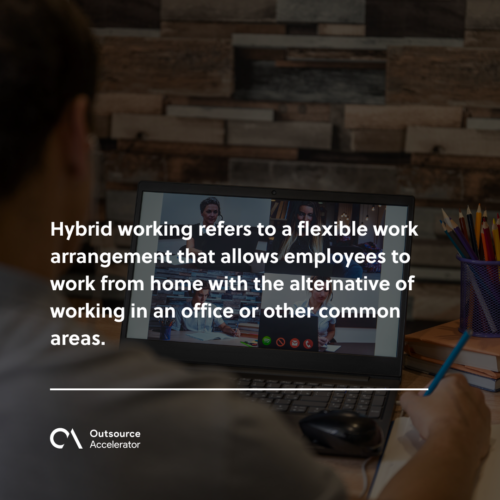Hybrid working
Definition
What is hybrid working?
Hybrid working refers to a flexible work arrangement that allows employees to work from home with the alternative of working in an office or other common areas.
The concept is a development from completely remote work, inspired by employees’ need to spend more time at home and less time in the office.
Employee expectations and needs have changed as a result of the increased demand for more flexible types of working arrangements, particularly hybrid working.
Organizations that do not embrace hybrid working may face higher employee turnover, poor employee engagement, and future restrictions on their capacity to acquire new talent.

The four pillars of successful hybrid working
To be successful, the attention must be on establishing a good infrastructure so that employees can operate productively in various settings. This involves developing systems that facilitate remote work, such as flexible work hours, corporate meetings, and time monitoring.
Several aspects determine effective hybrid working. Here are the four pillars crucial to effective hybrid working.
Culture
A clear and open culture that supports the company’s goals is the foundation for successful hybrid working. To achieve success for the organization, leaders must be visible, supportive, and empathic to their employees.
People
Inclusion and increased flexibility in where and when individuals work should be supported in hybrid working. Managers must maintain a connection with team members and identify any challenges to productivity, regardless of whether they’re in the office or at home.
Technology
Any remote-first company must have the necessary technical tools. All workers should be able to interact, cooperate, share knowledge, and talk as readily as they do in the office.
Technology’s role should be an enabler, assisting companies in transforming traditional to hybrid working.
Processes
You can’t just adopt workplace behaviors and expect employees to cope quickly with hybrid working. Processes must be redesigned for varied working environments.
What are the benefits of hybrid working?
One of the significant advantages of hybrid working is the ability to hire from a larger talent pool. Here are key advantages of hybrid work that you should be aware of.
Higher productivity
Most computer work can be done anywhere, and some people believe that without office distractions, they perform much better. However, this is not always the case for every employee.
An individual’s productivity can be influenced in various ways. For every individual who works successfully from home, another may require an office to attain the desired outcomes. In addition, employees at home may feel alone and out of sync with their teammates.
Hybrid working can help bridge the gap and meet the demands of both parties. Employees may be satisfied by having the flexibility to work from home or go into the office at any time.
Work satisfaction and wellbeing
Aside from increasing productivity, having flexibility over where they work might also boost an employee’s work satisfaction. Employees feel more in control of their working schedule and personal life now that they can work from anywhere they prefer.
Offering this kind of flexibility through hybrid working may lead to increased employee satisfaction, enhanced wellness, lower worker turnover, and a more motivated team to work with.

Better collaboration and working relationships
It’s no secret that in-person, office-based work, with its face-to-face encounters, improves collaboration. It encourages employee interaction, allowing them to converse during breaks and to exchange helpful suggestions.
While certain telecommuting solutions allow employees to engage, it is not the same as they would be in an office. Staff may benefit from a hybrid working arrangement since employees may collaborate to build personal relationships while also working remotely.
Effective tips on how to lead your hybrid team
Here are some tips on how you can effectively lead your hybrid working team for the success and growth of the company.
Make communication and collaboration a priority
Whether it’s remote or on-site work, some team leaders struggle with interacting with their subordinates for different reasons. Creating accounts on digital communication platforms like Slack can help improve communication even in the remote setup.
Staying connected in-person and online can boost morale, cross-functional cooperation, employee engagement, and productivity.
Ensure that every employee is visible and included
Visibility involves more than simply being aware of what work is being done. It includes sharing successes and allowing employees to express their thoughts, opinions, and concerns.
Managers should ensure that jobs are distributed effectively regardless of location, rather than giving preferential treatment to in-house staff.
All remote employees should be involved in team meetings or brainstorming sessions. Their views, thoughts, and perspectives are critical in making decisions.







 Independent
Independent




